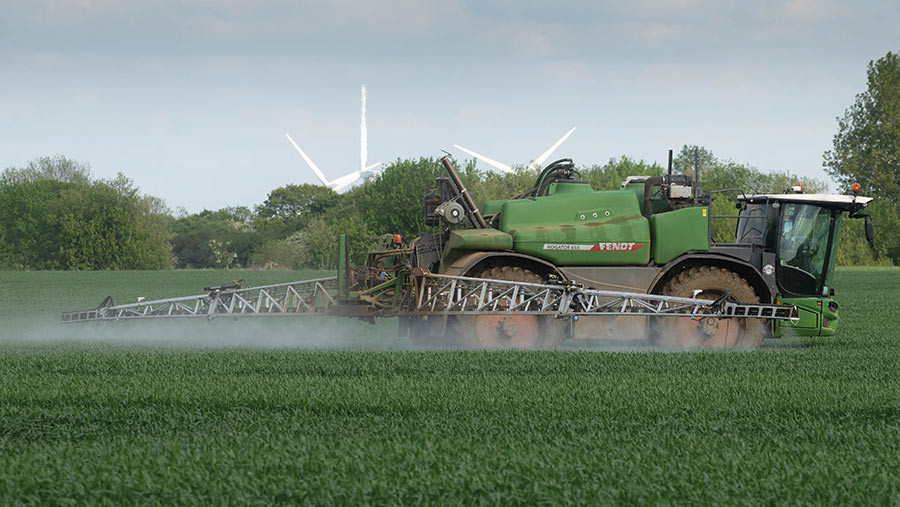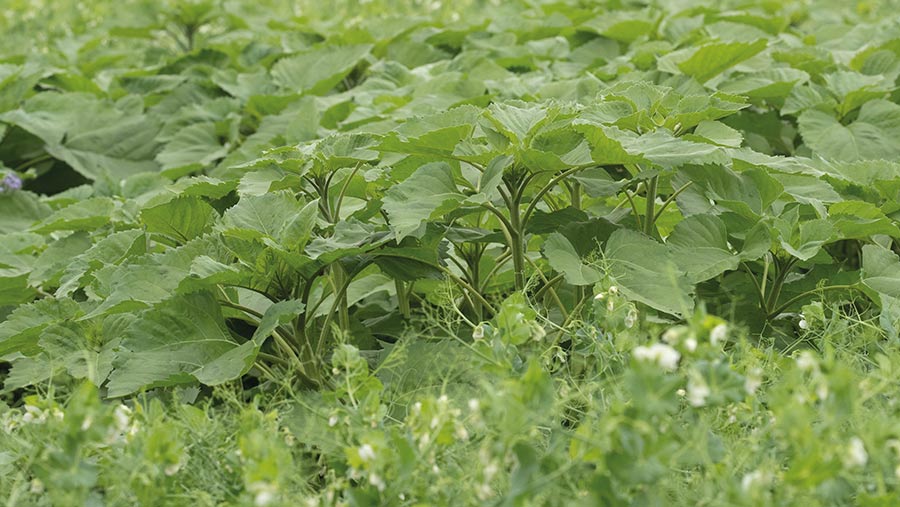Why cutting N fertiliser is a bigger challenge this season
 © Tim Scrivener
© Tim Scrivener High fertiliser prices are focusing minds on improving nutrient use, and two northern growers who successfully trimmed rates last year recognise the greater challenge this season.
Hutchinsons Helix East co-ordinator and crop nutrition specialist Rob Jewers says tests suggest the soil nitrogen supply is back to more typical levels for spring, compared with 2022.
See also: Why grain maize is key break crop in arable farmer’s rotation
Last year, farmers were getting 30-40kg/ha more from soil resulting from greater mineralisation and this allowed farmers to cut back with minimal impact.
However, this year they could see a much different response to reduced rates, which could result in plants losing tillers and have a greater impact on yield.
Mr Jewers explains that the lower soil reserves are due to last year’s higher crop yields combined with lower rainfall and more frosts. “Mineralisation happens when it’s warmer and there is more rain.”
Both Nick Wilson, who farms near Boroughbridge in North Yorkshire, and Thomas Todd, who farms near Cornhill-on-Tweed in Northumberland, have taken the lower soil reserves into account with their 2023 nutrient plans.
In mid-February they applied an early robust dose (60-80kg/ha) of nitrogen to their wheat crops, to compensate for the lower soil reserves and build biomass.
Both hope to make savings later in the season using technology trialled by the Hutchinsons Helix farm network.
Methylated urea
The first is methylated urea applied as a foliar N and Mr Jewers explains that it is applied to wheat in April, when there is plenty of leaf to take it up. Products include N Durance and Persist N.
Helix farm trials last year in Suffolk and North Yorkshire showed no detrimental impact on yield despite cutting back total nitrogen rates by about 30kg/ha.
In addition, Mr Todd has used it for three years in Northumberland and has not seen a decrease in yield, despite making a 30kg/ha saving on liquid N.
However, Mr Jewers highlights that when cutting back further (70kg/ha) with two applications (mid-March and April), they did see a drop-off in yield.
“You need that base and if you go too far, you will see an impact.”
His advice is that farmers can replace 30kg or more later in the season with one or two applications, but crops need 120-180kg/ha of base fertiliser before using methylated urea products.
N-fixing bacteria
Mr Jewers has also looked at Utrisha N from Corteva to see if it helps with nitrogen use efficiency.
The bacteria are applied to the leaf, which they then colonise. They draw in N from the atmosphere and supply the plant.
The hypothesis being tested is whether 160kg/ha of nitrogen plus Utrisha gives a similar response to 190kg/ha of bagged nitrogen.
“Results were mixed. However, it does seem to be doing something and trials are continuing this season,” he says.
R-Leaf is another product being trialled this year where the bacteria use nitrous oxide from the air and fix N in the leaf.
Lessons from the tailored approach
Both Northern Helix farmers are heavy users of precision farming technology, tailoring fertiliser applications to crop needs as the season progresses.
Here, we look at their nutrient approaches and what they learned from last season.
Nick Wilson, Boroughbridge, North Yorkshire
Nick Wilson used 160kg/ha last year, and is planning to do the same applied variably through the N sensor.
Historically, nitrogen use has been on the lower side at Hundayfield Farm, applied to a maximum of 220kg/ha on his group 3 wheats.
That’s because he focuses on margin rather than out-and-out yield.
Mr Wilson uses an N sensor to tailor applications of liquid NPKS based on crop requirements.
Trials carried out last year showed 130kg/ha gave the highest return, but he is cautious about making significant cuts based on a single year.
Instead, he aims to gain a better understanding of what is going on through trials to ensure his approach is sustainable for soils and not based on mining nutrients.
His biggest challenge is finding an alternative to cattle muck. The farm used to have cattle, but these have been replaced with sheep.
Farm facts: Nick Wilson
- Soil: Mostly sandy, clay loam and also have some quite gravelly areas and some clay
- Area: 250ha
- Cropping: Nine-year rotation including three year grass ley and cover crops. Cropping includes winter wheat, winter barley, oilseed rape, sometimes oats, spring barley, peas and fodder beet. Land is rented out for potatoes
- Establishment: Strip-till drill
Historically, there were fold yards and straw for muck deals. But he has a void for the next few years and says this could affect soil health.
He has imported pig muck before, but this brought in a brome problem and he is now using pig muck from a neighbour.
However, his manure strategy is changing. In the past, they were blanket applied in front of roots, but he now employs a targeted approach based on soil type.
Cover cropping has been used in the rotation for the past eight years, greatly helping to encourage soil biology.
Thomas Todd, Cornhill-on-Tweed, Northumberland
Thomas Todd takes a little-and-often approach with fertiliser on his farm, which lies within a rain shadow on the east of the Cheviot Hills.
His big issue is drought, with an average 610-711mm of rain a year and this influences his nitrogen strategy.
He uses variable-rate nitrogen maps based on satellite biomass data to even up crops, and rates are adjusted depending on rain.
He goes with five splits to help manage risk and fine-tune nitrogen.
“We can cut back areas if they drought out, such as the gravel ridges that can burn off.”
He avoids manures because of the blackgrass risk, and relies on cover crops and chopping straw to supply soils with organic matter and help stop wind erosion.
He has chopped everything at Barelees Farm for the past 20 years which has helped hold soil together, and cover cropped for 10 years.
Soil organic matter is now up to 4% and worm activity has improved.
Farm facts: Thomas Todd
- Soil: Sandy loam on glacial deposit and blow away sand
- Area: 290ha
- Cropping: Rotation of first wheat, second wheat, spring barley, oilseed rape and vining peas
- Establishment: Min-till with Horsch Terrano cultivator and Vaderstad drill
Cover crops hold onto nitrogen over winter – he has seen more than 100kg/ha of N left in soil, so has been able to cut back on fertiliser.
He also trialled the bacterial product Utrisha N in cereals and one tramline width in OSR and successfully replaced 30kg/ha.
Last year, he used 180kg/ha on his first wheat, 210kg/ha on second wheat, 140-150kg/ha on spring barley, and 180kg/ha on OSR.
This year, he hopes to fine tune N levels and is trialling the alternative N sources again.

© Hutchinsons
Phosphate and mobility
Applying starter phosphate can help encourage rooting, but care is needed on the source and placement.
Rob Jewers explains that while nitrogen has a typical efficiency of 50-60%, only 4-12% of phosphate is used by the plant.
He says distance from the root is key. Phosphate needs to be directly near the root to be picked up, as it doesn’t travel in soils.
So, given that it moves just 3.6mm in a season, applying triple super phosphate (TSP) on the surface will have little benefit in that season.
Applying more of a bioavailable form such as Primary-P, which is a microgranular form of diammonium-phosphate plus zinc also makes P available for longer.
Thomas Todd applies it with his wheat seed and last year saw a yield response, which Mr Jewers says is unusual with P.
He believes the extra rooting helped crops cope better with the dry summer, as they didn’t drought as badly.
Movement in soil
- Nitrate up to 8mm/day
- Phosphate 0.02mm/day (3.6mm in six months)

